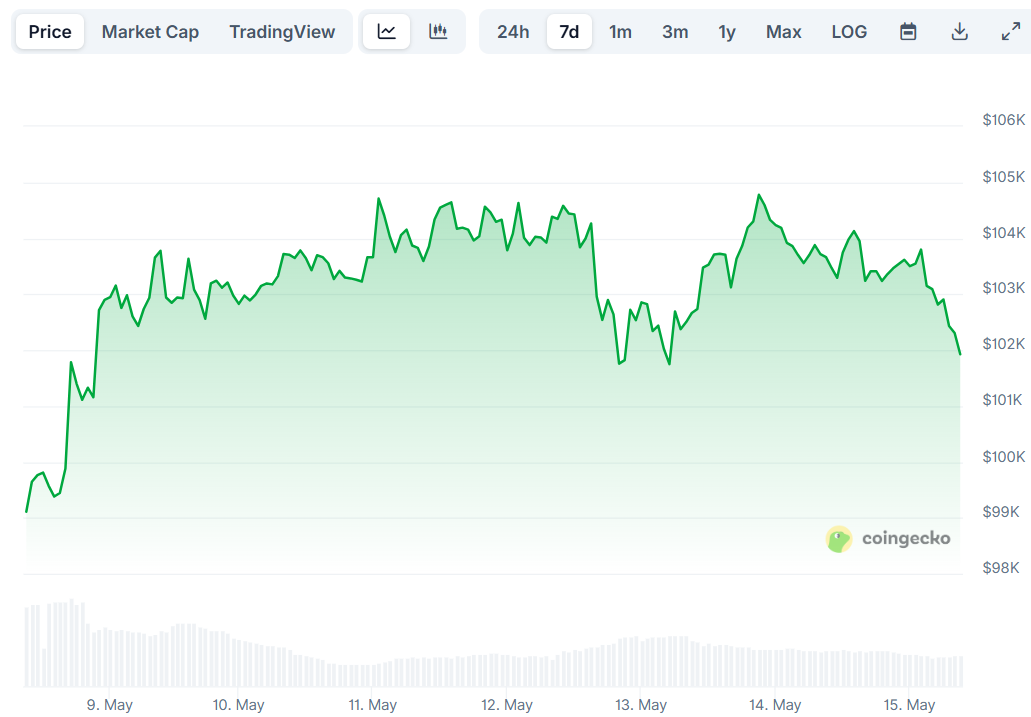TLDR
- Bitcoin has climbed above $104K, growing more than 20% over the last month
- Global institutional investors now appear to be driving the rally, replacing Korean retail traders
- Small investors have increased their participation by 3.4% since late April
- The Exchange Stablecoins Ratio has reached 5.3, potentially indicating selling pressure
- Technical indicators still point to continued bullish momentum despite caution signals
Bitcoin has pushed through the $104,000 price barrier, marking another milestone in its 2025 price action. The cryptocurrency is showing impressive strength with over 20% growth in the past month, even with a minor 0.4% pullback in recent 24-hour trading.
Market data reveals an interesting shift in the forces propelling Bitcoin’s current rally. This isn’t just another price increase – it represents a fundamental change in who’s buying.
According to research from CryptoQuant, the traditional “Korea Premium” – a measure that tracks price differences between Korean exchanges and global platforms – has been trending downward despite Bitcoin’s rising price.
This decline suggests something important about the current market structure. The rally isn’t being fueled by Korean retail traders as in previous cycles but instead by institutional investors from other markets.
The Korea Premium was a famous indicator during the 2017 and 2021 bull runs. During those periods, Bitcoin often traded up to 20% higher on Korean exchanges due to intense local demand.

Market Maturity Signs
This changing dynamic points to a maturing cryptocurrency market. As analyst Avocado Onchain explains, this represents a new phase in how capital flows through the crypto ecosystem.
The launch of spot Bitcoin ETFs in the United States has created new channels for institutional money to enter the market. Corporate treasuries and even sovereign funds are showing greater interest in Bitcoin exposure.
These developments have altered the trading landscape. Institutional strategies now drive more market activity than retail speculation – a stark contrast to previous bull markets.
Even as Bitcoin broke through major resistance levels in recent months, the Korea Premium remained subdued. This confirms the shift away from retail-driven price action that characterized earlier cycles.
The analyst notes that in the current market environment, any Korea Premium approaching 10% should be considered high. For context, this level would have been viewed as moderate during previous bull runs.
This absence of regional premiums shows that Asian retail traders no longer set the pace for Bitcoin markets. Instead, global institutions with access to specialized investment vehicles are leading the charge.
Retail Investors Return
While institutions dominate the current rally, smaller investors aren’t sitting on the sidelines. On-chain data shows retail participants – those with wallets holding under $10,000 in Bitcoin – are gradually increasing their market presence.
CryptoQuant analyst Carmelo Aleman tracked this trend using the BTC: Retail Investor 30-Day Change indicator. This metric turned positive on April 28 and has since shown a 3.4% increase in retail buying through mid-May.
Though retail investors typically don’t time markets as effectively as institutions, their behavior remains an important barometer for market sentiment. Their increasing participation creates a positive feedback loop that strengthens bullish market narratives.
Aleman suggests monitoring several other on-chain metrics alongside retail activity. Active addresses, UTXO count, new wallet creation, and transfer volume all tend to increase when retail interest grows.
These smaller investors often diversify into other crypto assets once they enter the market. This pattern could benefit the broader cryptocurrency ecosystem as the retail wave expands.
Warning Signals Emerge
Despite the optimistic indicators, some warning signs have appeared. The Exchange Stablecoins Ratio recently hit 5.3 as Bitcoin approached $104,000.
This metric compares Bitcoin reserves on exchanges to stablecoin balances. The current reading suggests that BTC reserves now exceed stablecoin reserves – a potential indicator of building selling pressure.
According to CryptoQuant contributor EgyHash, readings above 5.0 often precede market corrections. A similar spike to 6.1 in January was followed by a price pullback, suggesting investors might be converting Bitcoin positions back to cash.
However, Bitcoin continues to display bullish momentum on many technical indicators. The Stochastic RSI shows renewed strength, suggesting the upward trend could continue.
At the time of writing, Bitcoin trades at $103,993, maintaining its overall upward trajectory despite these mixed signals.






